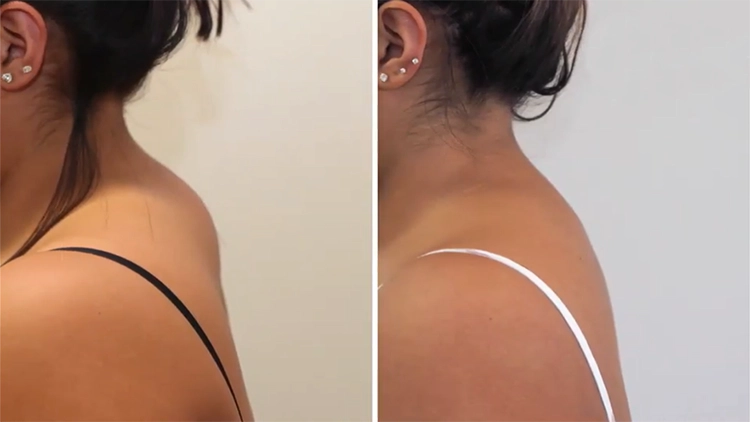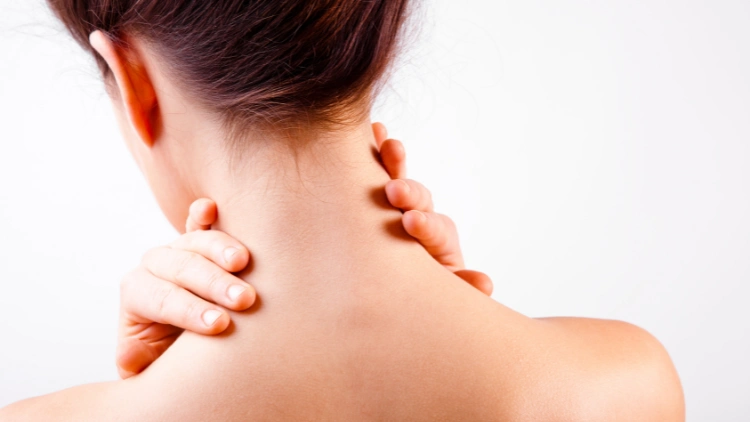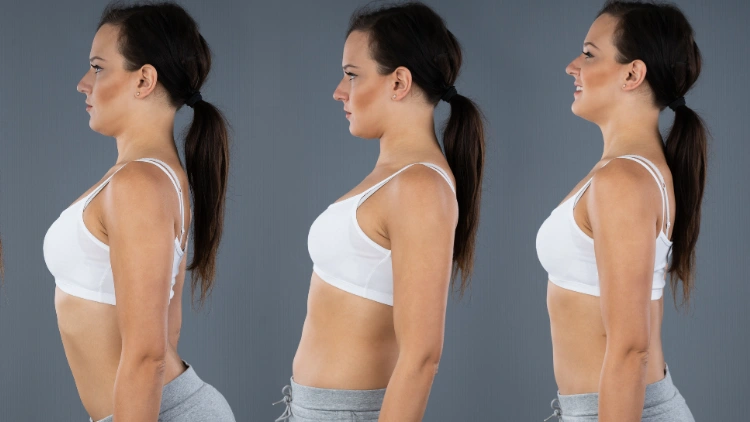
Those with a “buffalo neck hump” on the upper back just below the neck may feel embarrassed or insecure and wondering whether weight loss can eliminate a buffalo hump.1 We’ll cover various causes and solutions for this hump and explain whether weight loss will get rid of it or if you may need to seek other treatment.
We will also explain certain health conditions that can lead to this bump as well as ways to naturally lose excess fat in this area.
How Is Buffalo Hump Diagnosed?
Before addressing whether weight loss can eliminate a buffalo hump, let’s discuss how is buffalo hump diagnosed; first, anyone who notices a hump just below their neck on their upper back should consult their primary care physician.
From there–depending on the diagnosis or potential causes–they may advise you to make lifestyle changes if your hump is related to fat deposits on the neck or run more tests to determine the best way forward.
They might also recommend that you see a chiropractor or physical therapist (if the issue is postural) or a plastic surgeon if you’d like it removed for cosmetic reasons.
The causes of neck fat can be determined though:
- Assessment of Symptoms
- Blood Test to Check Hormone Levels
- Bone Density Test
- Checking Cortisol Levels
- CT Scan
- DEXA Scan
- MRI
It’s inadvisable to try to self-diagnose or self-treat without knowing what the cause of the hump is, so always get a professional opinion before coming up with a treatment plan–especially because a buffalo hump can be a symptom or telltale sign of some underlying issue or health condition.
Causes of Neck Fat & Buffalo Humps on the Neck
When receiving a proper diagnosis from a professional, the most common causes they may narrow it down to are:
Excess Body Fat
Pockets of extra body fat can collect in less than ideal places sometimes, and that can include upper back or upper neck fat. This is more common in overweight or obese people, as there is more fat to distribute in general and these excess fat deposits can appear anywhere.
Cushing’s Syndrome
The buffalo hump of Cushing’s syndrome is a telltale sign of Cushing’s–a disorder caused by the body overproducing cortisol for an extended period of time or long-term use of glucocorticoids to treat painful conditions like lupus–and refers to the high accumulation of fat behind the neck on the upper back.2
Other than the Cushing’s buffalo hump, other symptoms include unexplained weight gain, a round face, and large purple stretch marks.
Complications that may arise from Cushing’s include type 2 diabetes, insulin resistance, memory loss, heart attack, and stroke. Other than cortisol and glucocorticoids, Cushing’s Syndrome can be caused by tumors–especially in the pituitary gland.
Thyroid Issues
Thyroid disorders can cause sudden weight gain–especially around the neck and thyroid gland–and may present as a thyroid buffalo hump or back of neck fat rolls; other symptoms of thyroid issues include increased sweating, hair loss, and heart palpitations. Excessive weight gain due to a thyroid disorder is called hypothyroidism and is very common.
Dowager’s Hump
Dowager’s hump is often confused with back of neck fatty buffalo humps, but in this case the hump is not due to hormonal imbalance or excess fat. Instead, Dowager’s hump is essentially a forward curvature of the spine–called kyphosis–or excessive forward curvature, called hyperkyphosis.
This can occur due to aging, excessive resting weight on the upper spine and neck, or degeneration of discs in the spine which causes the bones to compress; it is most common in women, especially after age 40.3 With Dowager’s hump, the vertebrae are weakened and can cause the curvature to worsen and back pain to grow more severe.
Lipodystrophy
Lipodystrophy is a grouping of syndromes that essentially redistributes fat throughout the body, causing lessening of fat in some areas and increased fat deposits in others–including on organs. Lipodystrophy can begin at birth or at a later point in life, and often occurs in those with HIV-1.4
Genetics
A buffalo hump or excess fat deposit on the back of the neck can be due to a genetic predisposition, no matter what weight you are or whether or not you have hormonal imbalances.
Osteoporosis
Osteoporosis is a bone disease in which the bones thin, weaken, or experience a change in strength and structure. With lower density or strength, someone with osteoporosis is more likely to have bone fractures and breaks.
Certain medications can cause bone weakening, but most cases of osteoporosis are caused by aging, genetics, having a small or petite stature, or poor posture. Some demographics are more at risk–namely Asian and white women.
Treatments for low bone density or bone weakness include increasing calcium and vitamin D through changing one’s diet or taking supplements, getting regular light physical exercise, being cautious when walking to avoid falling, and refraining from smoking.5
Madelung’s Disease
Madelung’s disease is rare and its causes unknown; this disease is known by its symmetric deposits of subcutaneous adipose tissue below the back of the neck–causing a buffalo hump or ring of fat around neck–as well as in other areas including the cheeks, neck, trunk, and shoulders. Since this fatty tissue is usually painless, removals are not necessary unless they cause other issues, are deemed clinically necessary, or desired for cosmetic purposes.6
HIV-1
Because lipodystrophy is more common in adults with HIV-1 than the general population, “buffalo hump” or Dorso-cervical fat accumulation is often associated with HIV; in fact, most research on lipodystrophy has been done because of the push and dedication of AIDS activists. However, it remains unknown whether this fat redistribution occurs because of disease progression or as a side effect of HIV treatments.
Steroid Use & Medication
Certain types of medication can cause a hump behind the back of the neck, as can steroid use especially if taken long term.

Source: FredFroese via Canva.com7
No matter how closely one pays attention to their weight and nutrition, it’s possible to get a fatty build up or buffalo hump from steroids or corticosteroids including prednisone, hydrocortisone, cortisone.
If I Lose Weight Will My Buffalo Hump Go Away?
Now that we’ve covered many potential causes of a dorso-cervical hump, those asking whether weight loss can eliminate a buffalo hump can see how difficult this question is to answer; when it comes to a buffalo hump, weight loss certainly can help decrease the size or even fully get rid of it depending on the cause–but weight loss diets will not aid in decreasing the size of the hump if the cause is posture, medication, or other underlying conditions unrelated to weight.
In such cases, further intervention may be needed as trending diets or exercise will not suffice.
How Much Weight Do I Need To Lose to Get Rid of My Buffalo Hump?
There is no clear or universal answer to how much weight do I need to lose to get rid of my buffalo hump because this is dependent upon many variables including:
- Cause of Buffalo Hump
- Hormone Levels
- Starting Weight
- Body Composition
- Height
- Curvature of the Spine
- Mobility Level
- Medications
- Underlying Conditions (if any)
Regardless, don’t jump into working out 7 days a week or go overboard trying to get rid of the hump; it might feel humiliating to notice or to think others may see it but having a dorso-cervical hump is actually quite common and is usually able to be addressed no matter the cause. It’s okay to start following some weight loss tips for beginners but be sure to visit your doctor to get a proper diagnosis and come up with a helpful and personalized treatment plan.
Buffalo Hump Before & After Weight Loss (Results)
Although the size of a buffalo hump before and after weight loss may be smaller, this is not always the case; let’s see what a few people with buffalo humps have to say about their results after weight loss.
Richard
Richard didn’t have quite the outcome he’d hoped to after weight loss; he mentioned thinking that for him, the issue was posture because he’s currently at 210 lbs but even when he dropped to 180 lbs previously his hump was there all along–but did look slightly smaller.8 For Richard, weight loss seems to have minimized the size of the hump slightly but not to his level of satisfaction.
For him, the issue may be postural, hormonal, or due to one of the other aforementioned causes.
Avi
Avi noted that they were around 20 pounds overweight when their mom saw the lump and was very worried, thinking it was some sort of bone deformity. Avi mentioned that they were confident once they lost the weight it would go away and that they suspected the hump probably also had to do with hormone imbalances.
Avi went on to lose about 20 pounds and mentioned that the buffalo hump is now completely gone, stating that their mother was just as excited when she noticed.9 In Avi’s case, the hump must have been related to excess fat, as weight loss completely got rid of it.
Ways To Get Rid of Back Neck Fat Naturally (Ways To Get Rid of Buffalo Hump)
While definitively addressing whether weight loss can eliminate a buffalo hump without a diagnosis is challenging, we have several natural suggestions for reducing back neck fat (buffalo hump) that may be beneficial.
Although surgery may be needed in extreme cases, simply following easy diets for back pain or incorporating the 3 steps to lose weight–clean eating, exercise, and a healthy lifestyle–may get you started on the right track towards feeling better, experiencing less pain, shrinking the buffalo hump, and boosting your confidence.
It’s best to meet with your doctor to come up with the right plan for you and don’t change your medication, begin intensive exercise, or consider surgery without getting a consultation first. That being said, let’s check out a few potential recommendations you may get from your doctor to help get rid of your buffalo hump naturally.
Weight Loss
Weight loss can have a much broader impact than shrinking one’s hump, but this is an added benefit of getting fit and losing some excess fat. Thankfully losing weight can sometimes help make a buffalo hump somewhat smaller even if the underlying cause isn’t weight gain, as added fat deposits throughout the body will start to be burned off through workout out, eating clean and nutritious meals, and fostering healthy habits.
Exercise
Physical exercise burns calories, which can help decrease body fat to get rid of fatty tissue that a buffalo hump may consist of, but working out also has the added benefit of keeping muscles and bones strong and agile, aiding in proper posture to avoid other conditions such as osteoporosis and Dowager’s hump.
Improve Posture
Aside from excess weight, improper posture is the most common cause of a dorso-cervical hump; being mindful of your posture and doing gentle back and neck exercises to keep the muscles strong can aid in maintaining good posture.
Medication Changes
Certain medications can lead to weight gain or just different body composition, so speaking with your doctor about adjusting your medications may help reverse the impacts of a buffalo hump.
Eating calcium-rich foods or taking calcium supplements may also help, and increasing human growth hormone naturally through getting proper sleep, exercising, and eating a high protein diet can also decrease buffalo hump size.
Physical Therapy
Since improving posture cannot always be done on your own, in more severe cases, your doctor may recommend you visit a physical therapist to get more advanced postural treatment. Physical therapy can be very effective, as your therapist will work with you to strengthen upper back and neck muscles, increase mobility if some was lost due to spinal curvature or other conditions, and slowly decrease the size of your buffalo hump through specific exercises and movements.

Source: AndreyPopov via Canva.com10
There are many potential underlying causes of a dorso-cervical fatty hump or more informally “buffalo hump” that can range from hormonal disorders or postural issues to fat deposits due to excess weight. To those wondering whether weight loss can eliminate a buffalo hump, our best advice is sometimes–but consult with your doctor to determine a diagnosis and treatment plan that’s customized to your needs.
Frequently Asked Questions
Dowager's Hump vs Buffalo Hump: What's the Difference?
A common question about dorso-cervival humps is Dowager’s hump vs buffalo hump: what’s the difference? A buffalo hump and Dowager’s hump can describe the same thing, but not all buffalo humps are due to Dowager’s.
To better explain, a Dowager’s hump is caused by poor posture or even bone weakness, leading to a forward curvature of the spine. However, not all buffalo humps are posture-related and may be due to fat pockets, hormonal imbalances, HIV, steroids, or certain medications.
Will My Buffalo Hump Go Away If I Lose Weight or Will I Need Surgery?
Losing weight does not guarantee the disappearance of a buffalo hump, but rest assured that surgical intervention is rarely needed except in cases of extreme posture or bone issues, or if desired for cosmetic reasons.
Is My Buffalo Hump Just Excess Fat?
Excess fat can present anywhere in the body, showing up as a wider waist, thicker thighs, or even as a lower back fat hump or buffalo hump on the upper back. While many cases of buffalo hump are due to excess fat, not all are–so talk with your doctor to ensure there isn’t another underlying issue.
References
1Dr Eddy Dona. “BUFFALO HUMP LIPOSUCTION.” YouTube, 4 October 2018. Accessed 21 April 2023. <https://www.youtube.com/watch?v=-6p2tnvv95o>
2Hoenig, L. (2021, August 18). The Buffalo Hump of Cushing’s Syndrome. Clinical Dermatology, 40(5), 617-618. <https://pubmed.ncbi.nlm.nih.gov/36509510/>
3Lam, J., & Mukhdomi, T. (2022, August 8). Kyphosis. National Library of Medicine. Retrieved March 1, 2023, from <https://www.ncbi.nlm.nih.gov/books/NBK558945/>
4Projects Informing Perspective. (1999, April). Lipodystrophy. Projects Informing Perspective, 27, 14. <https://pubmed.ncbi.nlm.nih.gov/11366731/>
5National Institute of Arthritis and Musculoskeletal and Skin Diseases. (2017, March 15). Osteoporosis. MedLine Plus. Retrieved March 1, 2023, from <https://medlineplus.gov/osteoporosis.html>
6Chung, C.-C., Cheng, Y.-F., Chang, H.-P., & Lin, C.-Z. (2004, November). Madelung’s Disease. Journal of the Chinese Medical Association, 67(11), 591. <https://pubmed.ncbi.nlm.nih.gov/15720076/>
7FredFroese. “Neck Pain Massage.” Canva, Accessed 6 April 2023. <https://www.canva.com/photos/MAEE_YvUi64-neck-pain-massage/>
8u/ricksteer_p333. (2016, September 25). did anyone lose the hump on the back of their neck? Reddit. Retrieved March 1, 2023, from <https://www.reddit.com/r/loseit/comments/54dtjp/comment/d8116ft/>
9u/Aviis06. (2020, April 7). i got rid of my buffalo hump. Reddit. Retrieved March 1, 2023, from <https://www.reddit.com/r/loseit/comments/fwyrmk/i_got_rid_of_my_buffalo_hump/>
10AndreyPopov. “Woman With Lordosis, Kyphosis, Sway Back And Normal Curvature.” Canva, Accessed 6 April 2023. <https://www.canva.com/photos/MADqqrp_QMk-woman-with-lordosis-kyphosis-sway-back-and-normal-curvature/>